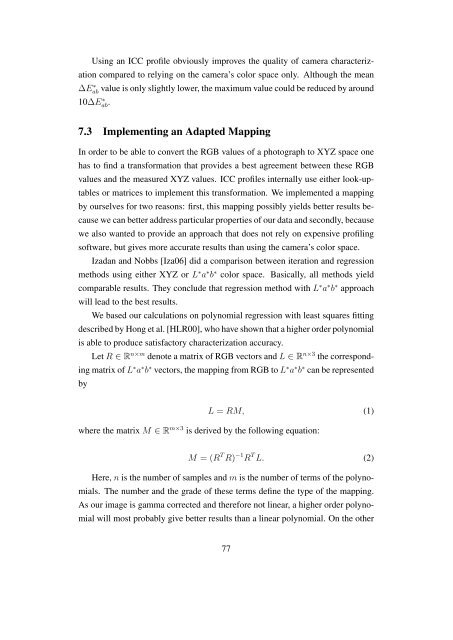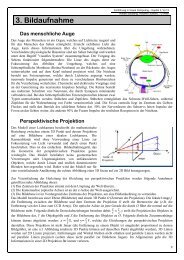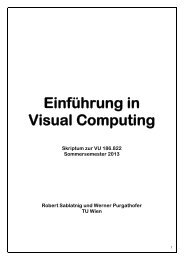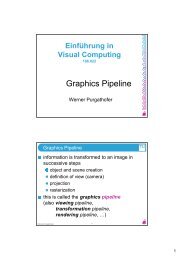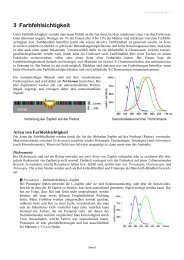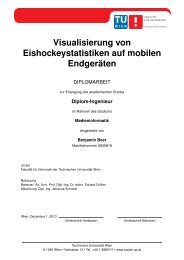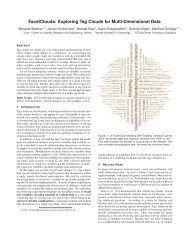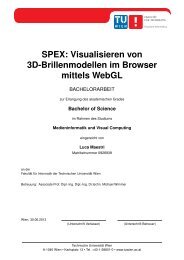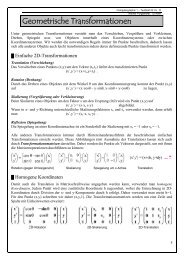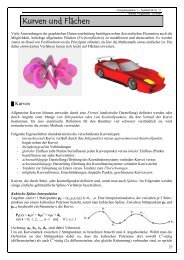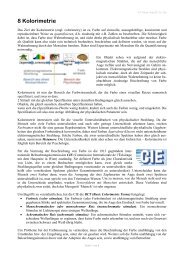Usability of Digital Cameras for Verifying Physically Based ...
Usability of Digital Cameras for Verifying Physically Based ...
Usability of Digital Cameras for Verifying Physically Based ...
You also want an ePaper? Increase the reach of your titles
YUMPU automatically turns print PDFs into web optimized ePapers that Google loves.
Using an ICC pr<strong>of</strong>ile obviously improves the quality <strong>of</strong> camera characteriz-<br />
ation compared to relying on the camera’s color space only. Although the mean<br />
∆E∗ ab<br />
10∆E∗ ab .<br />
value is only slightly lower, the maximum value could be reduced by around<br />
7.3 Implementing an Adapted Mapping<br />
In order to be able to convert the RGB values <strong>of</strong> a photograph to XYZ space one<br />
has to find a trans<strong>for</strong>mation that provides a best agreement between these RGB<br />
values and the measured XYZ values. ICC pr<strong>of</strong>iles internally use either look-up-<br />
tables or matrices to implement this trans<strong>for</strong>mation. We implemented a mapping<br />
by ourselves <strong>for</strong> two reasons: first, this mapping possibly yields better results be-<br />
cause we can better address particular properties <strong>of</strong> our data and secondly, because<br />
we also wanted to provide an approach that does not rely on expensive pr<strong>of</strong>iling<br />
s<strong>of</strong>tware, but gives more accurate results than using the camera’s color space.<br />
Izadan and Nobbs [Iza06] did a comparison between iteration and regression<br />
methods using either XYZ or L ∗ a ∗ b ∗ color space. Basically, all methods yield<br />
comparable results. They conclude that regression method with L ∗ a ∗ b ∗ approach<br />
will lead to the best results.<br />
We based our calculations on polynomial regression with least squares fitting<br />
described by Hong et al. [HLR00], who have shown that a higher order polynomial<br />
is able to produce satisfactory characterization accuracy.<br />
Let R ∈ R n×m denote a matrix <strong>of</strong> RGB vectors and L ∈ R n×3 the correspond-<br />
ing matrix <strong>of</strong> L ∗ a ∗ b ∗ vectors, the mapping from RGB to L ∗ a ∗ b ∗ can be represented<br />
by<br />
L = RM, (1)<br />
where the matrix M ∈ R m×3 is derived by the following equation:<br />
M = (R T R) −1 R T L. (2)<br />
Here, n is the number <strong>of</strong> samples and m is the number <strong>of</strong> terms <strong>of</strong> the polyno-<br />
mials. The number and the grade <strong>of</strong> these terms define the type <strong>of</strong> the mapping.<br />
As our image is gamma corrected and there<strong>for</strong>e not linear, a higher order polyno-<br />
mial will most probably give better results than a linear polynomial. On the other<br />
77


